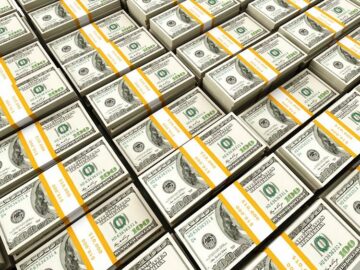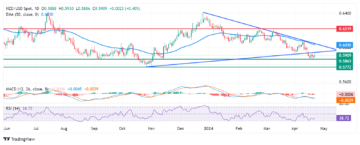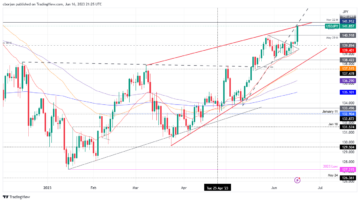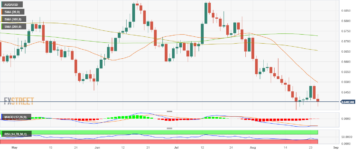
The European Central Bank (ECB) announced on Thursday that it left key rates unchanged following the April policy meeting, as expected. With this decision, the interest rate on the main refinancing operations, the interest rates on the marginal lending facility and the deposit facility will stay at 4.50%, 4.75% and 4.00%, respectively.
Follow our live coverage of the European Central Bank policy announcements and the market reaction.
Key takeaways from ECB policy statement
“Financing conditions remain restrictive and past interest rate increases continue to weigh on demand, which is helping to push down inflation.”
“Interest rates are at levels that are making a substantial contribution to ongoing disinflation process.”
“Future decisions will ensure that its policy rates will stay sufficiently restrictive for as long as necessary.”
“In any event, ECB will continue to follow a data-dependent and meeting-by-meeting approach to determining appropriate level and duration of restriction, and it is not pre-committing to a particular rate path.”
“APP and Pandemic Emergency Purchase Programme (PEPP) APP portfolio is declining at a measured and predictable pace, as Eurosystem no longer reinvests principal payments from maturing securities.”
“ECB intends to continue to reinvest, in full, principal payments from maturing securities purchased under pepp during first half of 2024.”
“Over second half of year, it intends to reduce PEPP portfolio by €7.5 billion per month on average.”
“ECB intends to discontinue reinvestments under PEPP at end of 2024.”
“ECB will continue applying flexibility in reinvesting redemptions coming due in pepp portfolio, with a view to countering risks to monetary policy transmission mechanism related to pandemic.”
Market reaction to ECB policy decision
The Euro stays under modest bearish pressure with the immediate reaction to the ECB policy announcements. At the time of press, EUR/USD was down 0.17% on the day at 1.0723.
Euro price this week
The table below shows the percentage change of Euro (EUR) against listed major currencies this week. Euro was the weakest against the US Dollar.
| USD | EUR | GBP | CAD | AUD | JPY | NZD | CHF | |
| USD | 0.98% | 0.66% | 0.62% | 0.74% | 0.89% | 0.32% | 0.88% | |
| EUR | -1.07% | -0.39% | -0.39% | -0.31% | -0.10% | -0.74% | -0.10% | |
| GBP | -0.70% | 0.32% | -0.05% | 0.04% | 0.20% | -0.35% | 0.22% | |
| CAD | -0.60% | 0.38% | 0.07% | 0.15% | 0.27% | -0.28% | 0.29% | |
| AUD | -0.74% | 0.24% | -0.08% | -0.12% | 0.12% | -0.43% | 0.13% | |
| JPY | -0.88% | 0.10% | -0.22% | -0.26% | -0.13% | -0.56% | 0.02% | |
| NZD | -0.32% | 0.65% | 0.34% | 0.27% | 0.41% | 0.57% | 0.55% | |
| CHF | -0.89% | 0.09% | -0.22% | -0.29% | -0.15% | 0.00% | -0.58% |
The heat map shows percentage changes of major currencies against each other. The base currency is picked from the left column, while the quote currency is picked from the top row. For example, if you pick the Euro from the left column and move along the horizontal line to the Japanese Yen, the percentage change displayed in the box will represent EUR (base)/JPY (quote).
This section below was published at 07:00 GMT as a preview of the European Central Bank’s monetary policy decisions.
- The European Central Bank will likely maintain rates on hold once again.
- ECB President Christine Lagarde could change its cautious tone and hint at an upcoming rate cut.
- US CPI was hotter than anticipated in March, triggering risk aversion.
- EUR/USD bearish case gains momentum as the pair stands below 1.0800.
The European Central Bank (ECB) will announce its monetary policy decision on Thursday. Market participants anticipate no changes to the current policy, but policymakers continue paving the way towards interest rate cuts in June. The ECB has tightened rates to fight skyrocketing inflation in the pandemic aftermath, lifting the Main Refinancing Operations Rate to 4.50% and the Deposit Facility Rate to 4% from negative levels in little over a year.
Beyond rates, the ECB is using other tools: the Asset Purchase Programme (APP) and the Pandemic Emergency Purchase Programme (PEPP). The first one is being reduced methodically and predictably as the Eurosystem ceases reinvestments from maturing securities. Regarding the PEPP, the central bank planned to reduce the portfolio by an average of €7.5 billion per month beginning in the latter half of 2024 and cease reinvestments under the PEPP by the close of 2024. No changes are expected there either in the April meeting.
European Central Bank interest rate decision: What to know in markets on Thursday
Major central banks kept rates steady in the first quarter of 2024, claiming they would need more data before reverting their current restrictive monetary policies. Overall, policymakers converge in interest rates having reached cycle peaks.
The United States (US) Federal Reserve (Fed) foresaw three rate cuts in 2024 in its December Summary of Economic Projections (SEP), and repeated it in the March document. However, recent comments from Chairman Jerome Powell cooled down expectations, as he said policymakers are in no rush to trim rates.
At this point, the ECB is likely to trim rates before the Fed, which would be quite notable and could put pressure on the EUR/USD pair.
The latest Hamburg Commercial Bank (HCOB) and S&P Global surveys delivered a positive surprise in the Eurozone as March Composite PMIs showed business activity expanded for the first time in over a year.
In the March meeting, the ECB projected headline inflation should fall from 5.4% in 2023 to 2.3% in 2024 and then to 2.0% in 2025, reaching 1.9% in 2026. At the same time, policymakers expect that real GDP should increase by 0.6% in 2024, by 1.5% in 2025 and by 1.6% in 2026.
The US published the March Consumer Price Index (CPI) on Wednesday, which was higher than anticipated, sending financial markets into a risk-averse spiral. The US Dollar soared, while stocks collapsed, as the figures gave the Fed plenty of time before trimming interest rates.
The EUR/USD pair heads into the ECB announcement gaining bearish momentum and trading well below the 1.0800 threshold.
What to expect from the ECB meeting and how could it impact EUR/USD?
The ECB is expected to keep the three main interest rates unchanged. In March, the central bank announced that “the interest rate on the main refinancing operations and the interest rates on the marginal lending facility and the deposit facility will remain unchanged at 4.50%, 4.75% and 4.00%, respectively.” The statement also reiterated that local policymakers aim to keep rates at current levels for as long as necessary and that decisions will be made based on data.
European policymakers have come a long way since their December meeting, when President Christine Lagarde’s efforts were on pushing back against rate cuts expectations. In these last three months, however, multiple policymakers have sounded much more optimistic about trimming rates as soon as June. The ECB seems more convinced than the Fed about the need to revert the current monetary policy.
Furthermore, macroeconomic data has reinforced market expectations for a rate cut, with money markets currently pricing in a cut for June, betting on 90 basis points (bps) of cuts by December and a total of 150 bps by September 2025.
Eurozone inflation slowed to 2.4% in March, according to preliminary data from Eurostat, better than expected. The core inflation rate, which excludes energy, food, alcohol and tobacco prices, also cooled to 2.9% from 3.1% in February, further boosting the odds for an upcoming rate cut.
If the ECB keeps rates on hold as expected, the focus will be on President Christine Lagarde’s press conference following the announcement. Lagarde has been cautious with her words, emphasizing the need to maintain rates higher for longer at the risk of price pressures resuming the advance and that policymakers are data-dependent. But if officials are actually thinking about a rate cut in June, they would need to pave the way for it in this meeting.
The Euro could appreciate as an initial reaction to the news, although rate cuts tend to weaken the currency. If the ECB trims rates before the Fed, EUR/USD should turn bearish. It may be a bit too early to consider that, but for sure, if Lagarde is more explicit on upcoming cuts, the market will react accordingly.
The EUR/USD pair plummeted with hotter-than-anticipated US inflation figures and has room to extend its slump. Valeria Bednarik, FXStreet Chief Analyst, notes: “Markets are all about central banks these days and the growing imbalances between the Fed and the ECB. The first one has not much to worry about, as inflation could be above the central bank’s goal, but is far from dramatic, while at the same time, the economy keeps growing at a healthy pace. The ECB, however, is still struggling to see economic growth, while inflation is closer to their around 2% target. There are growing chances the ECB could trim rates before the Fed, in which case, EUR/USD is just now kick-starting a bearish trend.”
Bednarik adds: “From a technical perspective, the daily chart supports additional slides, given that technical indicators retreated from their midlines and gained downward traction. Indicators head firmly south within negative levels, reflecting increased selling interest. At the same time, EUR/USD develops far below all its moving averages, with the 20 Simple Moving Average (SMA) accelerating south between the longer ones, also a sign of sellers taking over. Support comes at 1.0720 and 1.0685, while below the latter EUR/USD could test the 1.0600 mark. Near-term sellers are now aligned around 1.0800, while a firmer resistance level comes at 1.0870.”
ECB FAQs
The European Central Bank (ECB) in Frankfurt, Germany, is the reserve bank for the Eurozone. The ECB sets interest rates and manages monetary policy for the region. The ECB primary mandate is to maintain price stability, which means keeping inflation at around 2%. Its primary tool for achieving this is by raising or lowering interest rates. Relatively high interest rates will usually result in a stronger Euro and vice versa. The ECB Governing Council makes monetary policy decisions at meetings held eight times a year. Decisions are made by heads of the Eurozone national banks and six permanent members, including the President of the ECB, Christine Lagarde.
In extreme situations, the European Central Bank can enact a policy tool called Quantitative Easing. QE is the process by which the ECB prints Euros and uses them to buy assets – usually government or corporate bonds – from banks and other financial institutions. QE usually results in a weaker Euro. QE is a last resort when simply lowering interest rates is unlikely to achieve the objective of price stability. The ECB used it during the Great Financial Crisis in 2009-11, in 2015 when inflation remained stubbornly low, as well as during the covid pandemic.
Quantitative tightening (QT) is the reverse of QE. It is undertaken after QE when an economic recovery is underway and inflation starts rising. Whilst in QE the European Central Bank (ECB) purchases government and corporate bonds from financial institutions to provide them with liquidity, in QT the ECB stops buying more bonds, and stops reinvesting the principal maturing on the bonds it already holds. It is usually positive (or bullish) for the Euro.
- SEO Powered Content & PR Distribution. Get Amplified Today.
- PlatoData.Network Vertical Generative Ai. Empower Yourself. Access Here.
- PlatoAiStream. Web3 Intelligence. Knowledge Amplified. Access Here.
- PlatoESG. Carbon, CleanTech, Energy, Environment, Solar, Waste Management. Access Here.
- PlatoHealth. Biotech and Clinical Trials Intelligence. Access Here.
- Source: https://www.fxstreet.com/news/european-central-bank-preview-interest-rates-on-hold-as-markets-expect-first-cut-in-june-202404110700
- :has
- :is
- :not
- ][p
- 00
- 07
- 1
- 10
- 150
- 17
- 2%
- 20
- 2015
- 2023
- 2024
- 2025
- 2026
- 4
- 41
- 5
- 7
- 8
- 90
- a
- About
- above
- accelerating
- According
- accordingly
- Achieve
- achieving
- activity
- actually
- Additional
- Adds
- advance
- After
- aftermath
- again
- against
- aim
- Alcohol
- aligned
- All
- along
- already
- also
- Although
- an
- analyst
- and
- Announce
- announced
- Announcement
- Announcements
- anticipate
- Anticipated
- any
- app
- Applying
- appreciate
- approach
- appropriate
- April
- ARE
- around
- AS
- asset
- Assets
- At
- average
- aversion
- back
- Bank
- Banks
- base
- based
- basis
- BE
- bearish
- Bearish Momentum
- been
- before
- Beginning
- being
- below
- Better
- Betting
- between
- Billion
- Bit
- Bonds
- boosting
- Box
- Bullish
- business
- but
- buy
- Buying
- by
- called
- CAN
- case
- cautious
- cease
- central
- Central Bank
- Central Banks
- chances
- change
- Changes
- checked
- chief
- Christine
- CHRISTINE LAGARDE
- claiming
- Close
- closer
- collapsed
- Column
- COM
- come
- comes
- coming
- comments
- commercial
- conditions
- Conference
- Consider
- continue
- contribution
- converge
- convinced
- Core
- core inflation
- Corporate
- could
- Council
- countering
- Covid
- CPI
- crisis
- currencies
- Currency
- Current
- Currently
- Cut
- cuts
- cycle
- daily
- data
- day
- Days
- December
- decision
- decisions
- Declining
- delivered
- Demand
- deposit
- determining
- develops
- displayed
- document
- Dollar
- down
- downward
- dramatic
- due
- duration
- during
- each
- Early
- easing
- ECB
- Economic
- Economic growth
- economic recovery
- economy
- efforts
- eight
- either
- emergency
- emphasizing
- end
- ends
- energy
- ensure
- EUR
- EUR/USD
- Euro
- European
- European Central Bank
- Euros
- Eurozone
- Event
- example
- expanded
- expect
- expectations
- expected
- extend
- extreme
- Facility
- Fall
- FAQ
- far
- February
- Fed
- Federal
- federal reserve
- fight
- Figures
- financial
- financial crisis
- Financial institutions
- financing
- firmly
- First
- first time
- Flexibility
- Focus
- follow
- following
- food
- For
- foresaw
- forex
- frankfurt
- from
- full
- further
- future
- gained
- gaining
- Gains
- gave
- GDP
- Germany
- given
- Global
- GMT
- goal
- governing
- Government
- great
- Growing
- Growth
- Half
- hamburg
- Hamburg Commercial Bank
- Have
- having
- he
- head
- headline
- heads
- healthy
- Held
- helping
- her
- High
- higher
- hint
- hold
- holds
- Horizontal
- How
- However
- HTTPS
- if
- immediate
- Impact
- in
- Including
- Increase
- increased
- Increases
- Indicators
- inflation
- inflation figures
- inflation rate
- initial
- institutions
- intends
- interest
- INTEREST RATE
- Interest Rates
- into
- IT
- ITS
- Japanese
- Japanese Yen
- jerome
- jpg
- june
- just
- Keep
- keeping
- kept
- Key
- Know
- Lagarde
- Last
- latest
- latter
- left
- lending
- Level
- levels
- lifting
- likely
- Line
- Liquidity
- Listed
- little
- live
- local
- Long
- longer
- Low
- lowering
- Macroeconomic
- made
- Main
- maintain
- major
- MAKES
- Making
- manages
- mandate
- map
- March
- marginal
- mark
- Market
- market reaction
- Markets
- May..
- means
- measured
- mechanism
- meeting
- meetings
- Members
- modest
- module
- Momentum
- Monetary
- Monetary Policy
- money
- Month
- months
- more
- move
- moving
- moving average
- moving averages
- much
- multiple
- National
- National Banks
- necessary
- Need
- negative
- no
- notable
- Notes
- now
- objective
- Odds
- of
- officials
- on
- once
- ONE
- ones
- ongoing
- Operations
- Optimistic
- or
- Other
- our
- over
- overall
- Pace
- pair
- pandemic
- participants
- particular
- past
- path
- pave
- Paving
- payments
- per
- percentage
- permanent
- perspective
- pick
- picked
- planned
- plato
- Plato Data Intelligence
- PlatoData
- Plenty
- Point
- points
- policies
- policy
- policymakers
- portfolio
- positive
- Predictable
- preliminary
- president
- press
- pressure
- pressures
- Preview
- price
- Prices
- pricing
- primary
- Principal
- prints
- process
- programme
- projected
- projections
- provide
- published
- purchase
- purchased
- purchases
- Push
- Pushing
- put
- QE
- QT
- quantitative
- Quantitative Easing
- Quarter
- quite
- quote
- raising
- Rate
- Rates
- reached
- reaching
- React
- reaction
- real
- recent
- recovery
- redemptions
- reduce
- Reduced
- reflecting
- regarding
- region
- reinforced
- reinvest
- related
- relatively
- remain
- remained
- repeated
- represent
- Reserve
- reserve bank
- Resistance
- Resort
- restriction
- Restrictive
- result
- Results
- reverse
- revert
- reverting
- rising
- Risk
- risks
- Room
- ROW
- rush
- s
- S&P
- S&P Global
- Said
- same
- Second
- Section
- Securities
- see
- seems
- Sellers
- Selling
- sending
- September
- Sets
- should
- showed
- Shows
- sign
- Simple
- simply
- since
- situations
- SIX
- Slides
- slowed
- Slump
- SMA
- soared
- Soon
- sounded
- South
- spiral
- Stability
- stands
- starts
- Statement
- stay
- stays
- steady
- Still
- Stops
- stronger
- Struggling
- substantial
- SUMMARY
- support
- Supports
- sure
- surprise
- table
- Takeaways
- taking
- Target
- Technical
- tend
- than
- that
- The
- the Fed
- their
- Them
- then
- There.
- These
- they
- Thinking
- this
- this week
- three
- threshold
- thursday
- tightened
- tightening
- time
- times
- to
- tobacco
- TONE
- too
- tool
- tools
- top
- Total
- towards
- traction
- Trading
- transmission
- Trend
- triggering
- TURN
- unchanged
- under
- Underway
- unlikely
- upcoming
- us
- US Dollar
- us inflation
- used
- uses
- using
- usually
- v1
- versa
- vice
- View
- was
- Way..
- weaker
- Wednesday
- week
- weigh
- WELL
- were
- What
- when
- which
- while
- Whilst
- will
- with
- within
- words
- worry
- would
- year
- Yen
- you
- zephyrnet


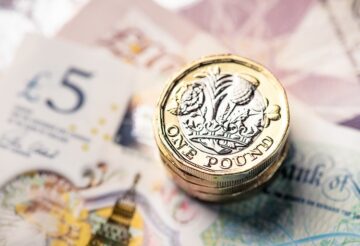
![Daily Stock Report: Elliott Wave technical analysis [Video]](https://platoaistream.net/wp-content/uploads/2023/07/daily-stock-report-elliott-wave-technical-analysis-video-360x270.jpg)
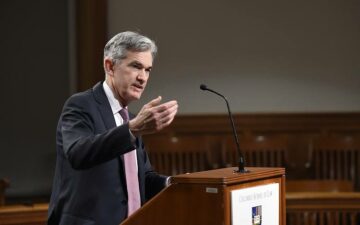
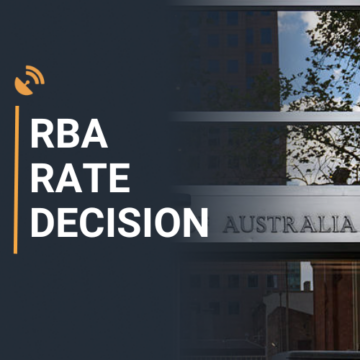
![Pound Sterling Price News and Forecast: GBP/USD slips on record debt, soft PMIs [Video]](https://platoaistream.net/wp-content/uploads/2023/01/pound-sterling-price-news-and-forecast-gbp-usd-slips-on-record-debt-soft-pmis-video-360x167.png)

